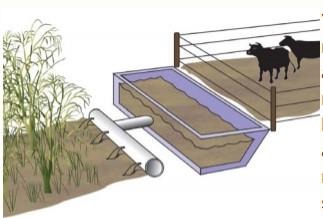By Parker Belgum
What is a VTA and how do they work?
A Vegetative Treatment system captures runoff from open feeding areas and then applies it to a permanently vegetated area to help prevent nutrient losses in a feeding / farm operation. These systems are built on or near feeding operations. The system captures the runoff from precipitation events. In Nebraska, the basins for these systems are designed to hold a 25-year 24-hour storm, expected solids accumulation, and 1 foot of extra storage called freeboard. The basins are designed based on the farms Nutrient Management Plan. These plans detail how much runoff and manure is captured and the amount of nutrients that will go into these basins. When a precipitation event occurs and the basins are filled, they must be drained or pumped within 72 hours per Title 130 enforced by Nebraska Department of Environment and Energy (NDEE).There are other design requirements that are listed out in a Review of Literature from UNL, Iowa State, and Kansas State. The stored runoff is then pumped or drained out of basin onto a field with a perennial forage crop. The effluent can be applied with a gravity irrigation system, a pod sprinkler system, or a full pivot irrigation system. In situations where it is hard to find sites that gravity can be used down gradient of a feedlot (e.g. where the pens are too close to waters of the state), it is often recommended to pump through irrigation equipment. The effluent carries nutrients from the manure that are useful for crop growth. These nutrients are then absorbed by the forage crop which is hayed and usually re-fed in the operation.

VTA systems help prevent deep percolation of nutrients into the soil. This could negatively affect water quality. This helps the farm with nitrogen and phosphorous management as it is being reused in a positive way so that it is not accumulating in the field. This in return provides not only a benefit in the forage but also a savings resulting from buying less feed and fertilizer since the nutrients in the manure are being used as a fertilizer. If you have other questions about how these systems work and store nutrients contact information for Nebraska organizations is at the end of the article (Additional Reading Options).
What size of operation can use one?
There are three different sizes of operations that Nebraska considers. They are categorized as small, medium, and large. For beef cattle, a small operation is considered anything less than 300 head, a medium is 300-999 head, and a large is anything above 1000 head. For other animal operations Chapter 1 of Nebraska Title 130 is what is used by the state to classify operation sizes. Small operations do not usually put in a VTA system as they do not produce enough manure or runoff to offset the cost of the system. However, some small operations because of a close connection to surface water may find VTA’s as a reasonable alternative. Medium operations are the most likely candidates to use a VTA system. These operations usually produce enough runoff and manure that it can be collected in the basin to reduce potential discharges to waters of the state and use the nutrients for plant growth. Large operations can use these systems. However, with the amount of manure and runoff that these operations will use runoff ponds and other methods to control their manure and runoff that complies with the Title 130 regulations for Nebraska. With this information any size of operation can use a VTA system however, the cost of these systems can deter some operations from implementing. They are very efficient in managing nutrients but there could be better options for large and small operations.
How nutrients are captured and reused
Along with reducing containments in ground water and surface waters VTA systems are designed to capture and reuse the nutrients that are available in the manure. Nitrogen and phosphorous are the main nutrients that are a concern in these systems. These systems use the top few feet of soil to capture the nutrients applied until used by vegetation. In the study “Effectiveness of a Passive Feedlot Runoff Control System Using a Vegetative Treatment Area for Nitrogen Control” they concluded “No water was measured exiting the VTA either below the root zone or at the down-gradient end. This indicated the solids basin discharge water was effectively used by the hay crop for production.” A study in Texas showed that for small swine operations 30-80 percent of nitrogen was captured and used by the forage in the system. This study also stated, “This would indicate the VTA had treated runoff well enough to be statistically similar to the background water quality of the surrounding rural and residential land use.”
Can you get assistance to build one?
To get started with the building and permitting process for a VTA there are some great resources in Nebraska. The first is NDEE. They can provide great assistance on permit information and any other questions that arise. Another great resource here in Nebraska is the Nebraska Natural Resources Conservation Service (NRCS). They provide technical support for design. There are some private engineering firms that design VTA systems and can put together Nutrient Management Plans for your operation. If you do choose to go with NRCS there is potential to sign up for programs that they offer and potentially get assistance with funding for the project. The best option is to contact your local NRCS field office in your county. In the interview with James Sueper he said “NRCS typically sees interest in around 2-3 VTA systems a year, then about 1 is funded per year. We used to do a lot more but now facilities aren’t growing as much as they used to.” For more information on VTA systems the UNL extension manure webpage has resources on VTA systems and other manure topics.
Source : unl.edu